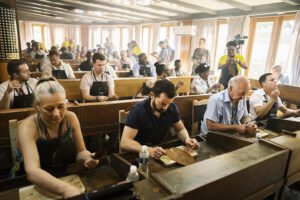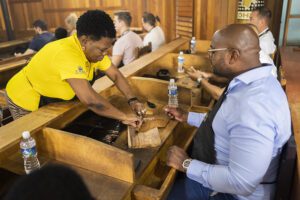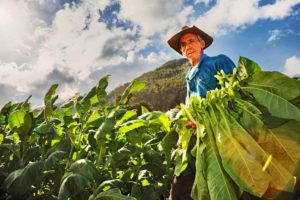Sanchez-Harguindey said that while the farms produced less tobacco in 2023, Habanos achieved a major increase in the value of its cigars due to a new pricing structure and successful promotions of exclusive brands such as Trinidad and Cohiba. “We’ve been able to compensate for that reduction in volume with value,” he said.
Habanos earned revenues of $721 million in 2023, up 31 percent compared to the previous year. Last year, the company generated $545 million in revenue, nearly 2 percent more than in 2021. “This is a year of records,” Sanchez-Harguindey said at the Festival del Habano, which took place Feb. 26—March 1.
The company’s products are available on five continents. During 2023, the markets that contributed most to Habanos’ sales volume were Spain, France, China, Germany and Switzerland. Habanos is owned 50 percent by the Cuban government and 50 percent by a consortium of Asian investors under the umbrella of companies called Allied Cigar Group, which is rumored to be majority-owned by HuaBoa, a major Chinese tobacco flavoring company. By region, Europe remains the leading market for Habanos, accounting for 56 percent of total sales value, followed by Asia (21 percent), the Americas (13 percent) and Africa and the Middle East (10 percent).
In 2023, the company launched 31 new products, including Cohiba Siglo de Oro, Cohiba Ideales, Romeo y Julieta Cupidos, Hoyo de Monterrey: Monterrey No. 4, and Bolivar New Gold Medal. With its 27 marcas and a presence in more than 130 countries, Jose Maria Lopez Inchaurbe, vice president of development for Habanos, credited the company’s success to “excellence, tradition and innovation.” A more obvious answer for the revenue jump is the boost in Cuban cigar prices globally. Habanos, said Lopez Inchaurbe, has transformed the Cuban cigar into a luxurious, high-end smoke in global markets, especially in China.
During the media portion of the festival, several reporters asked for clarification of Habanos’ revenues. Andrea Rodriguez, from the Associated Press, questioned how revenues went from 2 percent in 2022 to 30 percent this year. Lopez Inchaurbe said that there are different reasons to justify the growth. He said, “It’s a reality that after the pandemic, both the luxury market and the consumption of premium goods around the world have been increasing considerably,” and that demand has been global.
Lopez Inchaurbe said that the company also positioned its “super-premium” segment (Cohiba and Trinidad) more prominently and promoted the brands heavily in markets where luxury cigars are in greater demand. There has also been an increase in limited-edition cigar releases. “In the year 2023, we have launched 32 new products, nine of them in the premium standard category, which is the permanent portfolio of Havana, and 22 of them are in the concept of specialties,” he explained.
In 2022, Habanos announced a new “global pricing standard,” which massively increased the prices of Cuban cigars worldwide. The company has already announced at least two additional price increases for 2024. The price increases have significantly impacted the costs of Cuban cigars. Five years ago, the Cohiba Siglo IV, the flagship of the Cohiba brand, cost less than $60 a stick. Today, the cigar costs nearly $400 a stick in most markets. However, not all markets are treated equally.
Store shelves in Cuba were not heavily stocked during Tobacco Reporter’s visit. Finding large-ring-gauge cigars or anything with a Cohiba or Trinidad label was also difficult. Many local cigar shops in Havana said that they had not received shipments in more than a year, and some La Casa del Habanos (LCDH) locations said that it had been at least nine months since they had a cigar delivery. For the festival, however, every shop seemed to have received shipments of varying vitolas and marcas. Many shops had the new Romeo y Julieta Cupidos, 20 for $1,600, and boxes of the new Cohiba Siglo de Oro, priced at $4,500 for 18 sticks ($250 each).
An interesting, unusual occurrence was the introduction of a new POS system for payments during the festival. This system now allows Americans to purchase Cuban cigars (for consumption while on the island) with their U.S.-based credit cards, which has long been impossible. However, it is unclear whether this is a coincidence or if it was a permanent addition to the Cuban payment system. Tobacco Reporter was told that the new payment system is currently being used in only two of the LCDH stores in Cuba; however, it is expected to expand to all LCDH locations.






 In the past, registration for the Habanos Festival opened months before the event. However, last year, registration opened a mere 40 days before the event, and this year, Habanos gave attendees only 27 days to register. Overall, this year’s festival was better than most. The entertainment was spectacular, and the cigars were the best in the world.
In the past, registration for the Habanos Festival opened months before the event. However, last year, registration opened a mere 40 days before the event, and this year, Habanos gave attendees only 27 days to register. Overall, this year’s festival was better than most. The entertainment was spectacular, and the cigars were the best in the world.











 TabaCuba the state-run arm of Cuban cigar production, announced that it would increase its use of renewable energy sources in several of its facilities in Pinar del Rio, Cuba’s largest tobacco leaf-producing province.
TabaCuba the state-run arm of Cuban cigar production, announced that it would increase its use of renewable energy sources in several of its facilities in Pinar del Rio, Cuba’s largest tobacco leaf-producing province.


